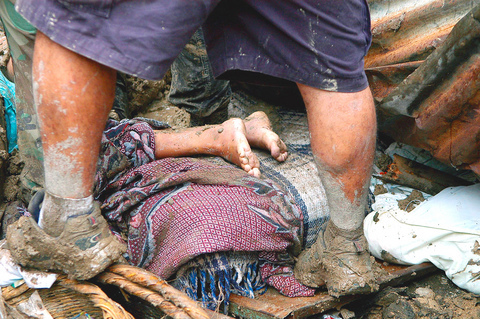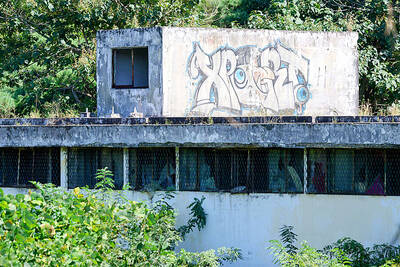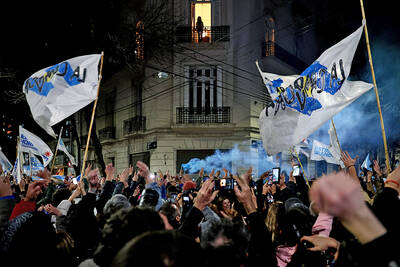Hurricane Stan knocked down trees, ripped roofs off homes and washed out bridges in southeastern Mexico, but it was the storms it helped spawn that were far more destructive, killing more than 65 people in Central America.
The former category one hurricane was losing strength over the Mexican state of Oaxaca. But forecasters said Stan triggered separate storms further to the south and officials in El Salvador's capital said 49 people had been killed, mostly due to two days of mudslides caused by rain around the country.
More than 16,700 Salvadorans had fled their homes for 167 shelters nationwide.

PHOTO: EPA
"This is a national tragedy because of the rains," said Eduardo Rivera, a spokesman for a team of Salvadoran rescue officials. "There isn't a corner of the country where there isn't pain and destruction to be found."
Among those evacuated were residents of Santa Tecla, outside the capital, San Salvador, where a strong earthquake caused a massive landslide in January four years ago. Officials have worried the mountain running alongside the neighborhood might collapse again with heavy rains or another quake.
A 4.8-magnitude earthquake did shake the Pacific Ocean off the Salvadoran coast on Tuesday, but there were no reports of injuries or major damage.
Neighboring Honduras said it would send aid to this country and Mexico also offered financial assistance.
Heavy rains also brought flooding that damaged bridges and submerged highways elsewhere in Central America.
Nine people died in Nicaragua, including six migrants believed to be Ecuadoreans killed in a boat wreck. Four deaths were reported in Honduras, three in Guatemala and one in Costa Rica.
In Mexico's Chiapas, wind and rain directly associated with Stan caused a river to break its banks and roar through the city of Tapachula, carrying homes of wood and metal with it and sparking hundreds of evacuations. Army and navy personnel joined state and local officials in helping residents flee to higher ground.
The city's center was littered with fallen branches and debris kicked up by flood waters and was virtually deserted on Tuesday night, as those not forced to evacuate holed up inside their homes.
Near Mexico's border with Guatemala, Tapachula was largely cut off from surrounding areas as major highways, roads and bridges were left under water. Chiapas Governor Pablo Salazar said four people were missing.
"Sadly, we know it's going to keep raining," Salazar said.
Hurricane Stan, which whipped up 130kph winds before being downgraded to a tropical depression, came ashore Tuesday morning along a sparsely populated stretch of coastline south of Veracruz, a busy port 295km east of Mexico City.
Its outer bands swiped the city, flooding low-lying neighborhoods and highways. Officials in Veracruz state, which includes the city of the same name, said seven people, including two children, were injured, most by falling trees or roofs that collapsed in the coastal towns of Alvarado and Montepio.
Schools around the state canceled classes and 38,000 people abandoned their homes, heading for shelters. Heavy rains also forced Veracruz's Mexican League soccer squad, the "Tiburones Rojos," or "Red Sharks," to scrap a scheduled practice.
All three of Mexico's Gulf coast crude-oil loading ports closed, but the shutdowns weren't expected to affect oil prices.
The crude-oil loading ports -- Coatzacoalcos, Dos Bocas and Cayo Arcas -- handle most of the 1.8 million barrels a day of crude oil exported by state-owned oil monopoly Petroleos Mexicanos, or Pemex.
Five exploratory oil platforms also were evacuated on Monday, but so far the storm hadn't affected the company's production of 3.4 million barrels a day of crude oil, Mexico's Communications and Transportation Department said.

LANDMARK CASE: ‘Every night we were dragged to US soldiers and sexually abused. Every week we were forced to undergo venereal disease tests,’ a victim said More than 100 South Korean women who were forced to work as prostitutes for US soldiers stationed in the country have filed a landmark lawsuit accusing Washington of abuse, their lawyers said yesterday. Historians and activists say tens of thousands of South Korean women worked for state-sanctioned brothels from the 1950s to 1980s, serving US troops stationed in country to protect the South from North Korea. In 2022, South Korea’s top court ruled that the government had illegally “established, managed and operated” such brothels for the US military, ordering it to pay about 120 plaintiffs compensation. Last week, 117 victims

China on Monday announced its first ever sanctions against an individual Japanese lawmaker, targeting China-born Hei Seki for “spreading fallacies” on issues such as Taiwan, Hong Kong and disputed islands, prompting a protest from Tokyo. Beijing has an ongoing spat with Tokyo over islands in the East China Sea claimed by both countries, and considers foreign criticism on sensitive political topics to be acts of interference. Seki, a naturalised Japanese citizen, “spread false information, colluded with Japanese anti-China forces, and wantonly attacked and smeared China”, foreign ministry spokesman Lin Jian told reporters on Monday. “For his own selfish interests, (Seki)

Argentine President Javier Milei on Sunday vowed to “accelerate” his libertarian reforms after a crushing defeat in Buenos Aires provincial elections. The 54-year-old economist has slashed public spending, dismissed tens of thousands of public employees and led a major deregulation drive since taking office in December 2023. He acknowledged his party’s “clear defeat” by the center-left Peronist movement in the elections to the legislature of Buenos Aires province, the country’s economic powerhouse. A deflated-sounding Milei admitted to unspecified “mistakes” which he vowed to “correct,” but said he would not be swayed “one millimeter” from his reform agenda. “We will deepen and accelerate it,” he

Japan yesterday heralded the coming-of-age of Japanese Prince Hisahito with an elaborate ceremony at the Imperial Palace, where a succession crisis is brewing. The nephew of Japanese Emperor Naruhito, Hisahito received a black silk-and-lacquer crown at the ceremony, which marks the beginning of his royal adult life. “Thank you very much for bestowing the crown today at the coming-of-age ceremony,” Hisahito said. “I will fulfill my duties, being aware of my responsibilities as an adult member of the imperial family.” Although the emperor has a daughter — Princess Aiko — the 23-year-old has been sidelined by the royal family’s male-only